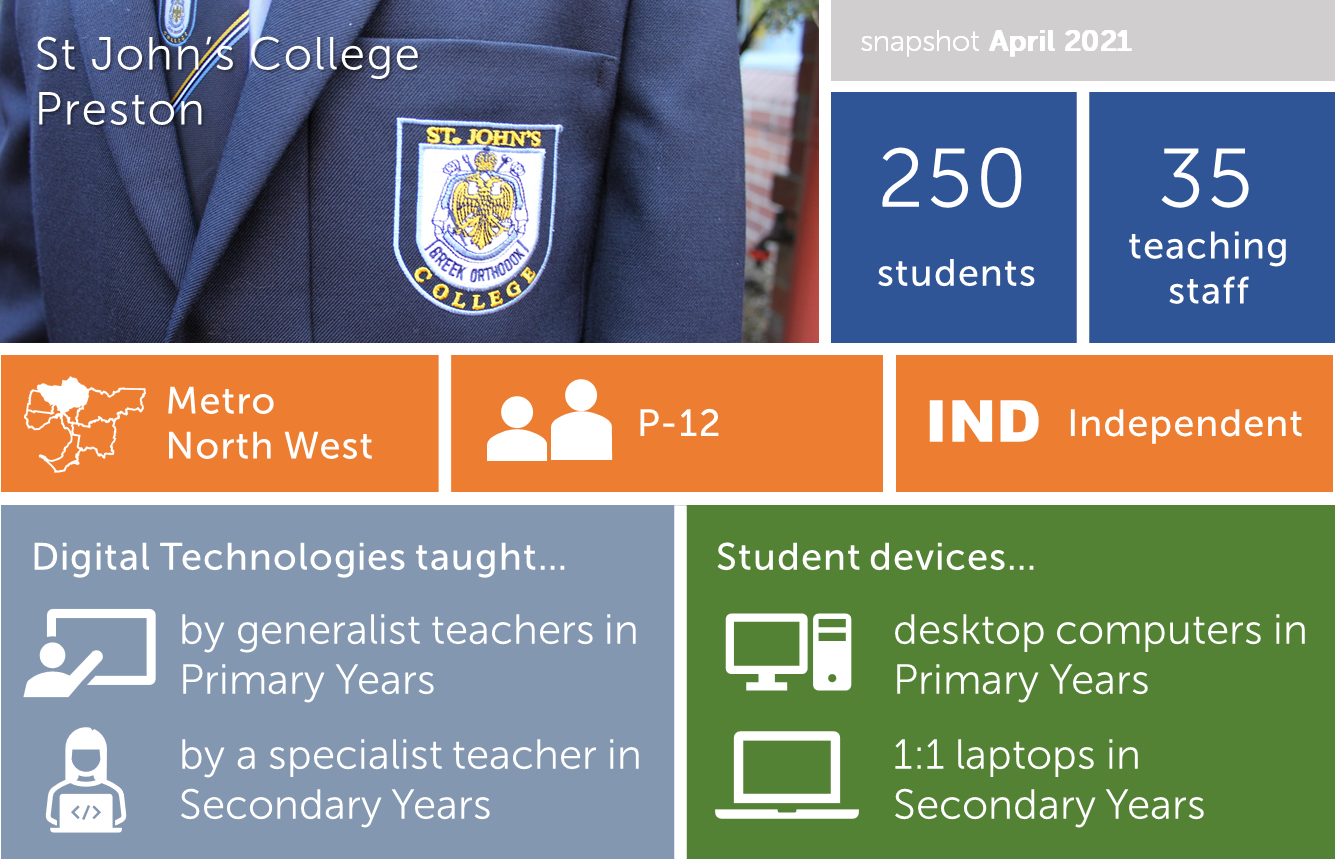ST JOHN'S COLLEGE, PRESTONCASE STUDY | snapshot April 2021 |
St John’s College is a small, independent P-12 school located in the Metro North East. They have approximately 250 students with single stream classes from Foundation to Year 12. Digital Technologies is taught by classroom teachers in the Primary years and by a specialist teacher in the Secondary years. 2020 was the first year that the Digital Technologies Curriculum was reported on. Years 9 and 10 are currently implemented as an elective. Primary students have access to a dedicated suite of desktop computers. This changes to 1:1 laptop access in Secondary years. Utilised tools include Sphero, Lego Mindstorms, Makey Makey, micro:bits and 3D printer. Software includes Microsoft Palette, Adobe Creative Suite, code.org, MS Tools, Scratch, HelloRuby.com and Makers Empire. Professional learningWhile there has not been any formal, targeted professional development for the Digital Technologies Curriculum, the college has been on the Microsoft School Transformation Programme in Term 3 and 4 in 2020. Since then, 9 staff at the college have become Microsoft Innovative Educators. Our biggest success Using hardware such as Sphero’s, EV3 Mindstorms and 3D printers has ignited a desire for students to want to know more about digital technologies. Up until this year (apart from Robotics) the school has not invested in technologies to engage students in this way. Our biggest challenge In Junior School, the biggest challenge has been to prepare teachers to teach the Digital Technologies Curriculum in their timetabled lesson. Creating, training and communicating with them the expectations for students has been and remains to be a challenge. Teachers have more familiarity with addressing the ICT capability, such as typing something up for English or to access a Maths website. In Senior School the biggest challenge has been to extend students beyond the visual based coding environments. Many students are ready to move to text-based (general purpose) programming; however, they lack the confidence to do so. This is an area for development in the College. As a whole school there is a need across the College to raise the awareness of Design Thinking as part of the learning behaviours expected at the College. |
GOING FORWARD What we identified for development Year 9 and 10 are still covering lower level content until prior knowledge is at sufficient level. This means they are still transitioning to a General Purpose language like Python / JavaScript. In future, we will look to using more advanced data structures. 3 things we would avoid or do differently
| INPUT FROM DLTV and ACS NOTE: This advice is relevant to this school snapshot as at April 2021, with documents provided at that time. starting out > building practices > consolidating practices St John's College already has many of the ingredients for a strong implementation of Digital Technologies with timetabled classes in the Secondary years, access to appropriate tools, and a growing understanding of the curriculum content by leading teachers. It is great to see the deliberate use of a design tool for coding (flowcharts) in the spotlighted unit. Encouraging and supporting the classroom teachers in the Junior school is a challenge that is just beginning. Dedicated time for teacher professional development on the Digital Technologies curriculum may be very beneficial at this point. This can include a clear delineation between ICT use and Digital Technologies, as well as time for formal communication of the new scope and sequence so that teachers can ensure they address all content descriptors adequately through the year level bands. DigiTech staff are aware of the importance of continuing to develop the teaching program to suit the needs of the students as they move into each year with more skills and prior knowledge than the previous cohort. Transitioning of Secondary students to general purpose programming is an example, and some other content descriptors are still to be addressed in Levels 7-10. |
CONTACT School contacts: Jac Manison (Head of Digital Practice) and Shae Warren (Digital Technologies and Secondary teacher) Phone: (03) 9480 5300 (school office) Email: School contact form |

